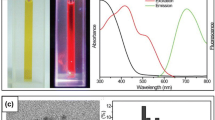Abstract
A biological sensor based on fluorescent organic nanocrystals (NCs) of Rhodamine B grown in sol–gel thin films was developed. The original signalization function is based on fluorescence contrasts of NCs, which exhibit a simple fluorescence signature, good photostability and higher fluorescence intensities compared to dispersed dye molecules. Thanks to a well-controlled dissolution process of the sol–gel surface, accurately followed by atomic force microscopy, the NCs were made emerging just a few nanometers above the silicate thin films to be directly accessible to biological macromolecules. Thus, hairpin-shaped DNA, functionalized by a probe-molecule (DNA probe), has been grafted onto nanocrystal surfaces leading to a fluorescence quenching by Forster resonance energy transfer. After hybridization of these hairpin-shaped DNA probes with their complementary DNA-target, the molecular probes and NCs are pulled apart, stopping thus the quenching. This “turn-on” of nanocrystal fluorescence allows thus a label-free DNA detection. The preparation methodology of the signalization function, its functionalization by hairpin-shaped DNA probes and first DNA-sensor experiments are presented.







Similar content being viewed by others
References
Cosnier S, Mailley P (2008) Recent advances in DNA sensors. Analyst 133(8):984–991. doi:10.1039/b803083a
Epstein JR, Biran I, Walt DR (2002) Fluorescence-based nucleic acid detection and microarrays. Anal Chim Acta 469(1):3–36. doi:10.1016/S0003-2670(02)00030-2
Launer HF (1968) Photobleaching-a common phenomenon. Nature 218(5137):160–161
Dubertret B, Calame M, Libchaber AJ (2001) Single-mismatch detection using gold-quenched fluorescent oligonucleotides. Nat Biotechnol 19(4):365–370. doi:10.1038/86762
Dubuisson E, Szunerits S, Bacia M, Pansu R, Ibanez A (2011) Fluorescent molecular nanocrystals anchored in sol–gel thin films: a label-free signalization function for biosensing applications. New J Chem 35(11):2416–2421. doi:10.1039/c1nj20353c
Dubuisson E, Monnier V, Sanz-Menez N, Boury B, Usson Y, Pansu RB, Ibanez A (2009) Brilliant molecular nanocrystals emerging from sol–gel thin films: towards a new generation of fluorescent biochips. Nanotechnology 20(31):315301
Monnier V, Sanz N, Botzung-Appert E, Bacia M, Ibanez A (2006) Confined nucleation and growth of organic nanocrystals in sol–gel matrices. J Mater Chem 16(15):1401–1409. doi:10.1039/b509833p
Lavalley V, Chaudouët P, Stambouli V (2007) An atomic force microscopy study of DNA hairpin probes monolabelled with gold nanoparticle: grafting and hybridization on oxide thin films. Surf Sci 601(23):5424–5432. doi:10.1016/j.susc.2007.09.015
Sanz N, Gaillot A-C, Usson Y, Baldeck PL, Ibanez A (2000) Organic nanocrystals grown in sol–gel coatings. J Mater Chem 10(12):2723–2726. doi:10.1039/b004989l
Sanz N, Zaccaro J, Delmotte L, Le Luyer C, Ibanez A (2002) Preparation and characterization of N-4-nitrophenyl-L-prolinol nanocrystals in sol–gel matrices. J Solid State Chem 165(1):25–34. doi:10.1006/jssc.2001.9485
Monnier V, Dubuisson E, Sanz-Menez N, Boury B, Rouessac V, Ayral A, Pansu RB, Ibanez A (2010) Selective chemical sensors based on fluorescent organic nanocrystals confined in sol–gel coatings of controlled porosity. Microporous Mesoporous Mater 132(3):531–537. doi:10.1016/j.micromeso.2010.04.004
Boury B, Corriu RJP (2002) Auto-organisation of hybrid organic–inorganic materials prepared by sol–gel chemistry. Chem Commun 8:795–802. doi:10.1039/b109040m
Dubuisson E, Pansu R, Ibanez A (2011) Fluorescent nanocrystals grown in sol–gel thin films for generic stable and sensitive sensors. J Solgel Sci Technol 57(3):258–262. doi:10.1007/s10971-010-2176-y
Monnier V, Sanz N, Pansu RB, Ibanez A. WO 2008/145875
Brinker CJ, Scherer GW (1990) Sol–gel science: the physics and chemistry of sol–gel processing. Academic Press, San Diego
Gratz AJ, Bird P, Quiro GB (1990) Dissolution of quartz in aqueous basic solution, 106–236 °C: surface kinetics of “perfect” crystallographic faces. Geochim Cosmochim Acta 54(11):2911–2922. doi:10.1016/0016-7037(90)90109-X
Claessens HA, van Straten MA (2004) Review on the chemical and thermal stability of stationary phases for reversed-phase liquid chromatography. J Chromatogr A 1060(1–2):23–41. doi:10.1016/j.chroma.2004.08.098
Leboda R, Mendyk E, Tertykh VA (1996) Effect of medium pH on hydrothermal treatment of silica gels (xerogels) in an autoclave. Mater Chem Phys 43(1):53–58. doi:10.1016/0254-0584(95)01604-S
Powell RC, Soos ZG (1975) Singlet exciton energy transfer in organic solids. J Lumin 11(1–2):1–45. doi:10.1016/0022-2313(75)90077-0
Tenery D, Gesquiere AJ (2009) Effect of PCBM concentration on photoluminescence properties of composite MEH-PPV/PCBM nanoparticles investigated by a Franck–Condon analysis of single-particle emission spectra. ChemPhysChem 10(14):2449–2457. doi:10.1002/cphc.200900413
Sam S, Touahir L, Salvador Andresa J, Allongue P, Chazalviel JN, Gouget-Laemmel AC, Henry de Villeneuve C, Moraillon A, Ozanam F, Gabouze N, Djebbar S (2009) Semiquantitative study of the EDC/NHS activation of acid terminal groups at modified porous silicon surfaces. Langmuir 26(2):809–814. doi:10.1021/la902220a
Updegrove TB, Correia JJ, Chen Y, Terry C, Wartell RM (2011) The stoichiometry of the Escherichia coli Hfq protein bound to RNA. RNA 17(3):489–500. doi:10.1261/rna.2452111
Naue N, Fedorov R, Pich A, Manstein DJ, Curth U (2011) Site-directed mutagenesis of the χ subunit of DNA polymerase III and single-stranded DNA-binding protein of E. coli reveals key residues for their interaction. Nucleic Acids Res 39(4):1398–1407. doi:10.1093/nar/gkq988
Yamasaki R, Kim J, Jung H, Lee H, Kawai T (2006) Dependence upon ionic strength in the immobilization of probing oligonucleotides onto streptavidin-modified probe surfaces. Biochem Eng J 29(1–2):125–128. doi:10.1016/j.bej.2005.03.015
Jain A, Liu R, Xiang YK, Ha T (2012) Single-molecule pull-down for studying protein interactions. Nat Protoc 7(3):445-452. http://www.nature.com/nprot/journal/v7/n3/abs/nprot.2011.452.html#supplementary-information
Zhou D, Li Y, Hall EAH, Abell C, Klenerman D (2011) A chelating dendritic ligand capped quantum dot: preparation, surface passivation, bioconjugation and specific DNA detection. Nanoscale 3(1):201–211. doi:10.1039/c0nr00462f
Vasdekis AE, Laporte GPJ (2011) Enhancing single molecule imaging in optofluidics and microfluidics. Int J Mol Sci 12(8):5135–5156
Lemaistre JP (2005) Disorder, intraband relaxation and dephasing of Frenkel excitons in molecular aggregates. J Lumin 112(1–4):407–410. doi:10.1016/j.jlumin.2004.09.036
Fadeev AY, McCarthy TJ (1999) Trialkylsilane monolayers covalently attached to silicon surfaces: wettability studies indicating that molecular topography contributes to contact angle hysteresis. Langmuir 15(11):3759–3766. doi:10.1021/la981486o
Sagiv J (1980) Organized monolayers by adsorption. 1. Formation and structure of oleophobic mixed monolayers on solid surfaces. J Am Chem Soc 102(1):92–98. doi:10.1021/ja00521a016
Acknowledgments
The French National Research Agency (ANR Brio+) and CNRS are gratefully acknowledged for financial support.
Author information
Authors and Affiliations
Corresponding author
Rights and permissions
About this article
Cite this article
Dubuisson, E., Marty, L., Cattoën, X. et al. Rhodamine B nanocrystals: elaborations, characterizations and functionalizations for biosensing applications. J Sol-Gel Sci Technol 72, 179–188 (2014). https://doi.org/10.1007/s10971-014-3431-4
Received:
Accepted:
Published:
Issue Date:
DOI: https://doi.org/10.1007/s10971-014-3431-4




